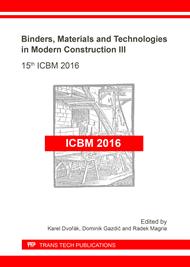[1]
T.Y. Lo, W.C. Tang, H.Z. Cui, The effects of aggregate properties on lightweight concrete, Build. Environ. 42 (2007) 3025–3029.
DOI: 10.1016/j.buildenv.2005.06.031
Google Scholar
[2]
J. Šeputytė-Jucikė, Impact of additives and lightweight aggregates on the structure and properties of thermal insulating cementitious composite, Doctoral dissertation, Vilnius Technika (2016).
Google Scholar
[3]
J. Šeputytė-Jucikė, M. Sinica, The effect of expanded glass and polystyrene waste on the properties of lightweight aggregate concrete, Eng. Struct. Technol. 8(1) (2016) 31-40.
DOI: 10.3846/2029882x.2016.1162671
Google Scholar
[4]
J. Alduaij, K. Alshaleh, M.N. Haque, K. Ellaithy, Lightweight concrete in hot coastal areas, Cem. Concr. Compos. 21 (1999) 453–458.
DOI: 10.1016/s0958-9465(99)00035-9
Google Scholar
[5]
R. Demirboga, R. Gul, Thermal conductivity and compressive strength of expanded perlite aggregate concrete with mineral admixtures, Energ. Build. 35 (2003) 1155–1159.
DOI: 10.1016/j.enbuild.2003.09.002
Google Scholar
[6]
N. Števulová , E. Terpáková, J. Čigášová, J. Junák, L. Kidalová, Chemically treated hemp shives as a suitable organic filler for lightweight composites preparing, Procedia Eng. 42 ( 2012 ) 948 – 954.
DOI: 10.1016/j.proeng.2012.07.488
Google Scholar
[7]
G. Balčiūnas, I. Pundienė,L. Lekūnaitė-Lukošiūnė, S. Vėjelis, A. Korjakins, Impact of hemp shives aggregate mineralization on physical–mechanical properties and structure of composite with cementitious binding material, Ind. Crops Prod. 77 (2015).
DOI: 10.1016/j.indcrop.2015.09.011
Google Scholar
[8]
C. Garnier, S. Prétot, F. Collet, Life assessment of hemp concrete wall manufactured by spraying, in: 2nd International conference on building energy and environment, Boulder, Colorado, (2012).
Google Scholar
[9]
F. Collet, J. Chamoin, S. Pretot, C. Lanos, Comparison of the hygric behaviour of three hemp concretes. Energ. Build. 62 (2013) 294–303.
DOI: 10.1016/j.enbuild.2013.03.010
Google Scholar
[10]
L. Arnaud, E. Gourlay, Experimental study of parameters influencing mechanical properties of hemp concretes, Constr. Build. Mater. 28 (2012) 50–56.
DOI: 10.1016/j.conbuildmat.2011.07.052
Google Scholar
[11]
M. Le Troedec, P. Dalmay, C. Patapy, C. Peyratout, A. Smith, T. Chotard, Mechanical properties of hemp lime reinforced mortars: Influence of chemical treatment of fibers. J Composite Mat 45 (2011) 2347-2357.
DOI: 10.1177/0021998311401088
Google Scholar
[12]
A. Shahzad, Hemp fibre and its composites – a review, J Composite Mat 45 (2011) 973-986.
Google Scholar
[13]
EN 12667: 2001, Thermal performance of building materials and products - Determination of thermal resistance by means of guarded hot plate and heat flow meter methods - Products of high and medium thermal resistance (2001).
DOI: 10.3403/02109602
Google Scholar
[14]
EN 12939: 2000, Thermal performance of building materials and products - Determination of thermal resistance by means of guarded hot plate and heat flow meter methods - Thick products of high and medium thermal resistance (2000).
DOI: 10.3403/02152153
Google Scholar
[15]
EN 826: 2013, Thermal insulating products for building applications - Determination of compression behaviour (2013).
Google Scholar


